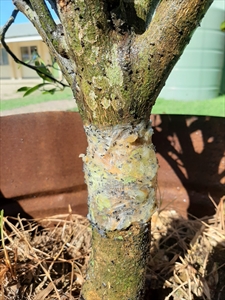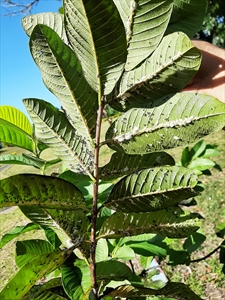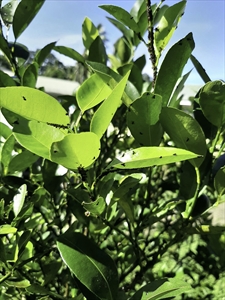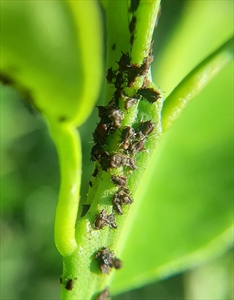Chilli. It is also known as chilli pepper, cayenne pepper, and pimento in Portuguese.
Pacific Pests, Pathogens, Weeds & Pesticides - Online edition
Pacific Pests, Pathogens, Weeds & Pesticides
Chilli pesticide (preparation & use) (504)
Capsicum frutescens; there are many other species that produce 'chillies', e.g., Capsicum annuum, Capsicum baccatum, Capsicum chinense, and Capsicum pubescens. They are all members of the nightshade family, the Solanaceae.
Worldwide; the origin of the cultivated species is thought to be South America.
Chilli contains capsaicin, a chemical which causes a painful burning or stinging sensation on skin and eyes. It can also cause pain and vomiting if swallowed. There are many varieties and each has a different concentration of the chemical.
Capsaicin concentration is measured using the Scoville scale of heat units - SHU). Below are estimates of SHU for common varieties:
- Habanero (Red Savina) = 350,000 to 750,000 SHU
- Habanero (Fiji Bongo Chili) = 100,000 to 350,000 SHU
- Nepalese Akabare = 100,000 to 350,000 SHU
- Bird’s Eye = 50,000 to 100,000 SHU
Because size and weight of fruits (and SHU) vary between varieties, and the environments in which they are grown, an approximation of the number of fruits to use is necessary for home-made chilli sprays. The following is given as a guide:
- Bird’s Eye – 20g/L fresh weight (about 30 ripe fruits)
- Bongo chili/Akabare – 10g/L fresh weight (about 5 ripe fruits)
- Red Savina – 5g/L fresh weight (about 3 ripe fruits)
- Estimate the amount of spray needed; remember you do not have to spray every leaf of every infested plant. If the insects are in groups, spot-sprays may be sufficient.
- Collect mature to fully ripe chillies; the number depends on the chilli variety you are using to make the spray. See above.
- Wear Personal Protection Equipment (PPE). See Safety precautions below.
- Crush and pound the chillies, working them into a paste.
- Place the paste on a fine muslin cloth and bring the sides together making a cloth bag enclosing the paste. Place the cloth bag in a bucket adding sufficient water to cover the bag for at least 1 hour, preferably overnight.
- After soaking, squeeze the juice from the bag with hands protected by rubber gloves or plastic bags.
- For each 1L water of the final mix, add 10ml (1 bottle cap) cooking oil and 5g (1/2 bottle cap) bar soap (preferably vegetable Castile soap).
- Check to see if the mix contains plant material which might block the sprayer. If it does, strain through fine muslin or a metal strainer.
- Add water to achieve final volume; pour into the sprayer, and use.
1. Vegetable crops:
- Use chilli sprays to control aphids on cabbage, chilli, capsicum, eggplant, and cucurbits. Early detection is important and spot spraying is recommended.
- Similarly, use chilli sprays to control thrips on eggplant, using an integrated approach (see Fact Sheet no. 86).
- Note: when ant populations are high, it is difficult for natural enemies to be involved in management strategies, and so they have to be removed.
2. Tree crops:
- Tree crops, e.g., guava, citrus, breadfruit, mango, can be managed effectively from damaging sucking pests such as Toxoptera aphid and Icerya scale – if the plants/trees are young and or trimmed to a manageable height. This is what can be done:
3. White-footed ants, aphids (citrus) and Icerya seychellarum scales (guava):
- Disrupt the symbiotic relationship between ants, aphids and scales.
- Place a band of sticky tape around the trunks of trees and add grease or tangle foot (Photos 1&2). Prune branches touching the ground, other plants, or any structures that provide ants a bridge to colonise the trees to tend aphids and scale insects for their honeydew.
- Spot-spray ants, colonies of aphids (Phots 3) and scales (Photo 4), instantly killing most of them (Photo5). After a few hours or a day, the aphids are dead (Photo 6), and the scale survivors have died with loss of mealy cover exposing their orange bodies (Photo 7)
- Decide if it is appropriate to re-spray or allow natural enemies to feed on the scales.
- Note: frequent monitoring and pruning must be done to ensure no bridges reform allowing ants access to the scales.
4. Organic producers:
- The chilli spray can be used on crops grown according to the Pacific Organic Standard as long as the ingredients of the spray - vegetable oil, soap and chillies comply.
- Under the Pacific Organic Standard, a vegetable oil is allowed – as a processing aid in greasing or releasing agent (as long as it is not sourced from a GMO product). Plant oils, e.g., castor and neem are encouraged, but their compliance should be checked.
- Wear appropriate PPE: light overalls, rubber gloves, rubber boots, mask, (plastic) goggles, and hat when preparing and applying chilli spray to avoid skin and eye burns.
- If PPE unavailable wear long-sleeved shirt and trousers and protect mouth from inhaling capsaicin droplets, protect hands inside plastic bags (see Fact Sheet no. 288) Note, the more potent the variety of chilli, the more the burning sensation.
- Take all necessary precautions from the time of picking the chillies to preparation and storage of the spray. Store chilli spray away from kitchens and out of the reach of children, preferably a locked cupboard.
- Contact a doctor immediately if the spray is swallowed or it contacts the skin and causes serious harm.
- Avoid spraying in windy conditions as drift can cause irritation and increase risk to the spray person. Often, the best time to spray is early morning or later afternoon when it is less windy.
AUTHOUR: Mani Mua & Grahame Jackson
Information from Pacific Organic Standard. SPC Land Resources Division, Suva, Fiji. (https://lrd.spc.int/pacific-organic-standards); and Scoville heat scale. Wikipedia. (https://en.wikipedia.org/wiki/Scoville_scale). and from Maskey B, et al. (2021) Post-harvest quality of fresh Akabare chili (Capsicum chinese) as affected by hydrocooling, package modification and storage temperature. International Journal of Food Properties. (https://www.tandfonline.com/doi/pdf/10.1080/10942912.2020.1865399).
Produced with support from the Australian Centre for International Agricultural Research under project HORT/2016/185: Responding to emerging pest and disease threats to horticulture in the Pacific islands, implemented by the University of Queensland and the Secretariat of the Pacific Community.










